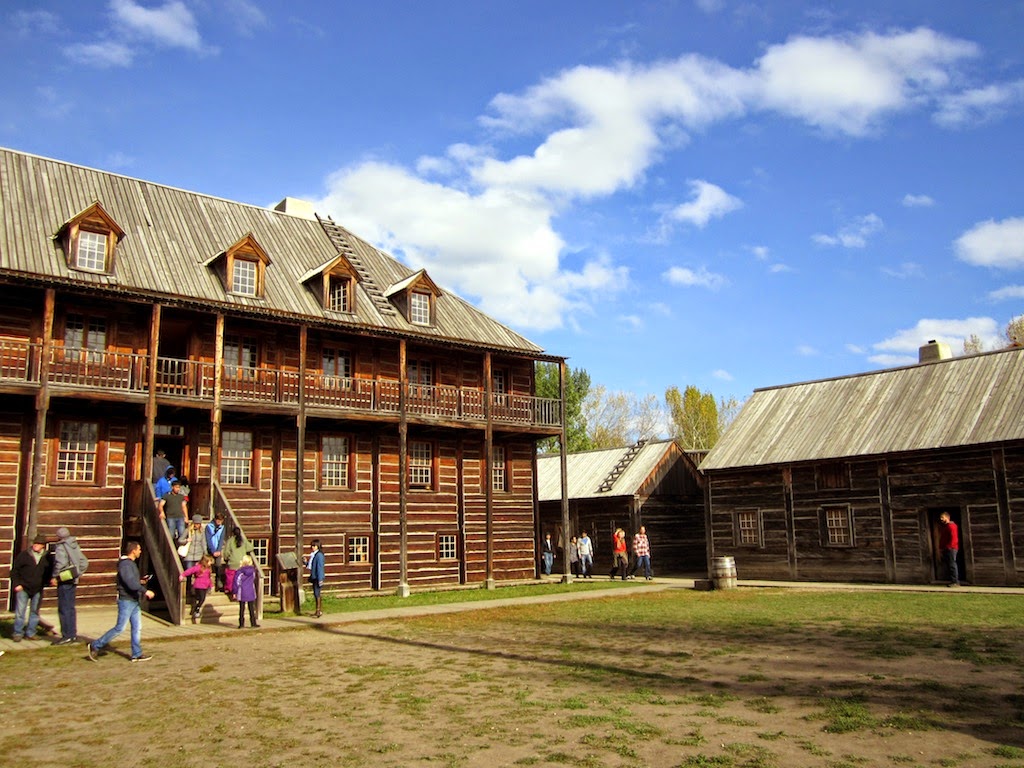Upon entering the gate we found ourselves on train station platform (though unfortunately the old steam engine was not running that day), facing the 1920s midway.
We continued along the boardwalk down 1920 Street, passing a farm with rows of freshly threshed haystacks, a motordrome of classic cars, and the oldest mosque in Canada.
We entered the rural telephone exchange building to watch a "call girl" connecting phone calls on a large switchboard.
We checked out the curious remedies lining the shelves of the drug store and looked at home-made colourful sugar candy for sale next door in the confectionary.
Across the street we stopped to watch a fifteen-minute film on Edmonton's history at the Capitol Theatre. The film started as an old black and white picture, then unexpectedly converted to a fantastic 3-D feature. The 3-D effect was achieved by projecting images onto different layers of screens, and the walls and ceiling were utilized as well. In one scene styrofoam "snow" even fell from the ceiling! Next door we passed the red brick Hotel Selkirk, where visitors can stop for lunch.
We turned the corner onto 1905 Street, stopping at the combined fire hall, town hall, and police station.
Across the road we visited the Bank of Montreal and the post office, where an actor told us about the weekly five-hour lineups people endured to collect their mail! Upstairs was a law office.
Next door was a photography shop, where people could pay to pose for portraits in period costume. We checked out the hand-cranked film boxes in the Penny Arcade and across the street stopped by St. Anthony's Church and its adjoining school house.
Next door was a tent city, necessitated as Edmonton's population growth exceeded the rate at which contractors could build accommodation. An old-fashioned family warmed up by a fire while an elderly man wrote a letter in a tent nearby.
Across the road we toured the houses of several wealthy Edmonton families, including Rutherford, the founder of the University of Alberta. They even had electricity and indoor bathrooms! On the contrary, the farmhouse family next door subsisted with an outhouse. They did, however, have a large barn and horse paddock. We entered a little white Anglican Church which looked just like Shady Creek United Church on East Saanich Road.
On 1885 Street we entered the Dominion Land Office to see how land was distributed by "land scrip". We entered a Northwest Mounted Police outpost, then toured their gun shed and twelve-cell jail. A mountie walked past with a fluffy buffalo jacket on over his red coat. We toured several houses, a livery shop, blacksmith shop, general store, saloon, bakery, doctor's office, drug store, hardware store, millinery (hat shop), shoe shop, harness shop, and carpentry shop. Often small living quarters were built over or behind these businesses and we saw actor families working in the shops and relaxing in the living quarters.
We saw old printing machinery in the bulletin building. At the end of the street was another one-room schoolhouse and a sizeable homestead, with pigs, turkeys, sheep, cows, and horses.
We stopped at the Trading Post to check out their Native jewellery and coonskin hat souvenirs then continued down the street to the 1846 Hudson Bay Company fort. Within its high guard-tower-topped walls, Fort Edmonton was a self-sufficient community. We wandered through the many wooden buildings, including living quarters, a blacksmith shop, meat store, chapel, and clay bake oven.
The dominating building, an excessively large four-storey house, was home to the factor. The beds were covered with classic HBC blankets and the cellar was well stocked with rum.
In the back of the Fort we watched HBC workers constructing a york boat.
Teepees were set up outside the Fort, where Native fur traders stayed while doing business with the HBC. We saw the trading post inside the fort, where furs could be exchanged for European goods -- flour and food stuffs, cooking utensils, weapons, and clothing, amongst other things. The trading post keeper showed us the different kinds of furs: beaver (a bit oily and coarse), wolf, skunk, badger, lynx (the softest and most sought-after by European ladies), coyote, and fisher.
Surrounding the fort was ploughed farmland, recently harvested. We enjoyed a First Nations traditional dance performance, accompanied by drummers.
I think Fort Edmonton Park was probably the most worthwhile place to visit on free admission day. The huge land area easily accommodates the thousands of visitors; unlike attractions like the zoo which would likely have felt quite crowded. Though I was skeptical that it might be too gimmicky, I thought that the Park did an excellent job of designing and maintaining its buildings. It's an attraction that is interesting to visitors of all ages and offers an interactive lesson in Edmonton's history. What better way to learn about the past than to travel back in time -- and that is really what it felt like!
The food options in the Park were somewhat limited, with hot dogs and poutine being most readily available. I was happy that I had packed a protein bar and water bottle. I think the Park could do very well setting up food and drink stands, especially if they offered more traditional items like bannock. Perhaps they already do this in the busier summer months. Autumn really is a lovely time to visit though, crunching through fallen leaves beneath the golden birches. And of course it's a great time of the year for kids -- every leaf pile we passed had a few jumping around in it!














































No comments:
Post a Comment